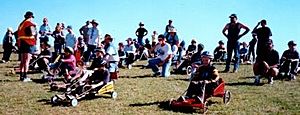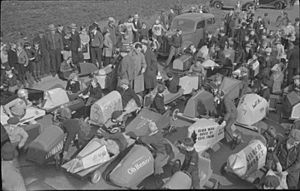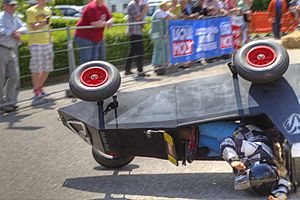Gravity racer facts for kids
A gravity racer or soapbox is a special kind of car that doesn't have an engine. It races downhill using only the power of gravity. These cool vehicles are often called "soapboxes" because the first ones were made from old wooden soap crates!
People race soapboxes either to see who can finish fastest or to compete against others. While many are built just for fun, some teams take the sport seriously and aim to win. These racers can go really fast, sometimes even over 160 km/h (100 miles per hour)!
Contents
What are Soapbox Cars?
Long ago, gravity racer cars were simple. They were built from wooden soap or apple crates and used old rollerskate wheels. But over time, they've become much more advanced. Today, builders use materials like aluminium, fiberglass, and even strong, lightweight materials like carbon fiber.
These cars have many names around the world! In the United Kingdom, they're called buggies, trolleys, or carts. Now, soapbox is the most popular name there. In Scotland and northern England, you might hear them called bogies or carties. In Wales, they're often known as gambos. In Australia, they're famous as billy-carts, and in Brazil, they're called rolimã.
Kids often build these cars, but there are also big races and competitions for adults. These events, sometimes called "soapbox or billycart derbies," are usually more about having fun than serious winning. They often help raise money for charity. Many races have simple rules like these:
- The car must not have a motor.
- It needs at least four wheels.
- The car should have some kind of brakes.
- The driver must wear a helmet for safety.
- A small push at the start is usually allowed to get going.
Most soapbox cars weigh about 68 kg (150 lb). They can reach speeds of 32 to 48 km/h (20 to 30 mph). Some cities even have special tracks where drivers compete for prizes!
How are Soapbox Cars Built?
A typical gravity racer cart is often made from steel. It usually has four wheels. The back wheels are fixed, while the front wheels can steer. Steering is often very simple, using a single central pivot point. The driver sits at the back, and sometimes the seat area is enclosed, just like the original soapbox designs. More advanced cars might even have a fully enclosed body to make them more aerodynamic.
The wheels used can be anything easy to find. Wheels from baby carriages, strollers, or old bicycles are common. You can also buy ready-made wheels from hardware stores. Steering is often done with a rope connected to the front axle. This rope can also be used to pull the cart.
More complex steering systems are sometimes used. Brakes are also very common, and most races require them. Often, a simple brake that rubs against one of the tires is enough, even if it's not super effective.
Gravity racer carts don't have engines. They are either pushed by helpers or rolled down a hill. Races usually happen downhill, and the car that is built best and driven most skillfully will win. This is because gravity pulls on all cars equally.
Building a gravity racer is a great project for kids! It helps them learn about engineering and basic building skills. You can also buy pre-designed kits, but many people prefer to build their own from scratch.
Recently, some very advanced gravity racers have appeared. These are made for major competitions and might use carbon fiber and a special strong design called a monocoque. However, most still use a more traditional chassis or spaceframe with a body made from materials like plywood or corrugated plastic. Examples include the Lotus 119c and the Formula Gravity VXR Nimbus.
In Australia, billy carts often stick to a more traditional style, even today. Kids often build them informally using found or cheap materials, with little help from adults. They are often used without safety gear. However, even in organized events, like the annual Cub Scout Billy Cart Derby, the cars are still built to a simple design, though safety is always considered.
In Indonesia, billy carts are called 'gokar'. They are raced in communities as a fun social activity. Their design is similar to Australian billy carts, but they often use motorcycle wheel bearings for wheels.
In Brazil, gravity racers are known as "carrinhos de rolimã." These traditional designs are very basic. They have an open, board-like body and wheels made from bare ball bearings (no tires allowed). These bearings are usually old parts from car mechanics.
There are also electric soapboxes, but these are not true gravity racers because they use electric power.
How Gravity Racers Work (Physics)
A gravity racer gets all its speed from the force of gravity. Imagine you're at the top of a hill; gravity wants to pull you down. This "pull" gives the car energy.
However, things like air resistance (called aerodynamic drag) and friction from the wheels (called rolling resistance) slow the car down.
- Rolling resistance can be reduced by using good wheel bearings, the right tire sizes, and making sure the tires are pumped up properly. Higher tire pressure and narrower tires usually mean less rolling resistance, but they might also mean less grip on the road. Bigger wheels also have less rolling resistance than smaller ones.
- Aerodynamic drag is the air pushing against the car. You can reduce this by making the car's body smooth and shaped like a teardrop, which helps it cut through the air.
Because of these slowing forces, a heavier car will often go faster than a lighter one if they have the same shape. This is why many races have rules about how much a car can weigh. Also, cars with lighter wheels will speed up faster than cars with heavier wheels.
Images for kids
-
A gravity race in Montreal, 1948. The first recorded gravity race happened in 1904 in Oberursel, Germany. It was inspired by big motor races like the Gordon Bennett Cup.
-
A gravity racer derby at a community celebration in Minnesota.
See also
 In Spanish: Goitibera para niños
In Spanish: Goitibera para niños







